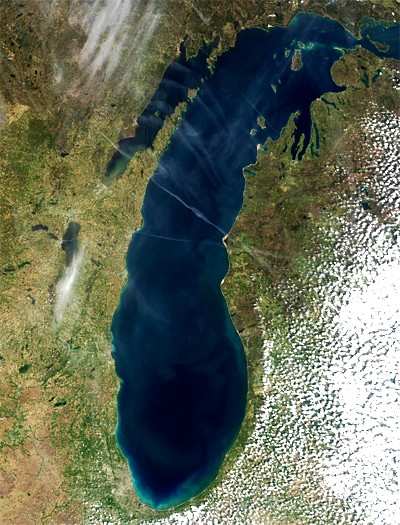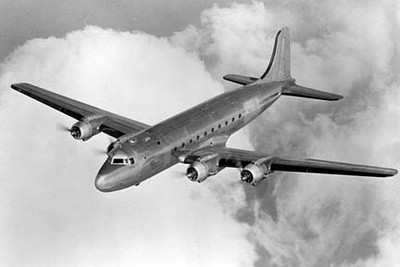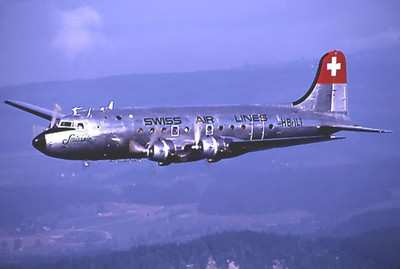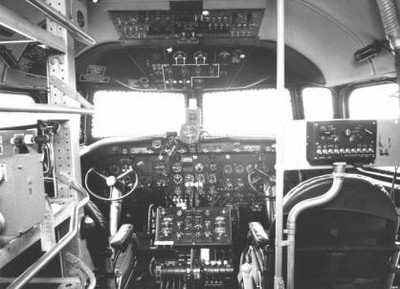Northwest Flight 2501 Will Keep Its Secrets For Now
By Aero-News Senior Correspondent Kevin R.C. "Hognose"
O'Brien
The sea does not give up her dead casually; and neither do the
freshwater inland seas, the Great Lakes that define much of the
north central US and southern Canada. So when Michigan Shipwreck
Research Associates (MSRA) decided to take on the case of Northwest
Flight 2501, a Douglas DC-4 lost in 1950 with 55 passengers, two
pilots, and a stewardess over vast Lake Michigan, they knew it was
going to be hard. They didn't know how hard -- or that they'd wind
up solving other, even older mysteries, while chasing Flight
2501.

The Flight
In 1950, long-range air travel was almost unimaginably different
from today. The poor and middle-class rode trains; flying was for
the well-to-do, the busy, the family in a hurry. Northwest Airlines
Flight 2501 carried 27 women, 22 men and six children on the night
of June 23, 1950. The captain was Robert C. Lind, the co-pilot
Verne F. Wolfe, and the only stewardess Bonnie Ann Feldman.
Flight 2501 was a coast-to-coast overnight trip from New York to
Seattle, with a stop midway, at Minneapolis. Unlike today's
airliners, the unpressurized DC-4 would travel at low altitudes --
2501 was flight-planned at 6,000 feet, although it flew lower. The
passengers were seated in comfortable, roomy seats, and to some
extent pampered. And every seat had an ashtray in the armrest --
almost everybody smoked in those days.
In the early 1950s, the airlines managed their own air traffic.
At 11:51 PM Eastern Time, Flight 2501 reported over Battle Creek,
Michigan at 3,500 feet. His ETA in Milwaukee, Wisconsin on the west
side of the lake was 46 minutes later. He made only one more
transmission, requesting a lower altitude (2,500) due to weather;
that request was denied.
No voice from flight 2501 was ever heard again.

The Loss
When NWA 2501 didn't make its ETA in Milwaukee, Northwest Radio
and Civil Aeronautics Administration (CAA) stations tried to raise
the aircraft with no luck. Soon, search and rescue forces were
called out; at 0530 Milwaukee time, the airplane would have
exhausted its maximum fuel and could no longer be in the air --
even theoretically. The Coast Guard and state and local forces
started looking in the most likely place --Lake Michigan.
There had been other air traffic over the lake that night, none
of which had seen the ill-fated liner, but everybody over Lake
Michigan was dodging thunderstorms. Had the DC-4 hit one? Was it in
the lake?
By 6:30 that evening, the Coast Guard had evidence it was: the
cutter Woodbine found an oil slick, and aircraft debris, miles from
any shore. In the airline debris was a logbook from Northwest
Airlines. No survivors were found, but over the next two weeks the
lake yielded up human body parts and some small aircraft parts or
passengers' effects. For several days, until the July 4 weekend,
local beaches were closed, protecting bathers from grisly
discoveries. But none of the debris provided a solid clue to the
loss of the machine.
There were no survivors. At that time, the loss of 58 human
lives was the greatest single casualty toll in the history of civil
aviation.
The Coast Guard and Navy located wreckage by sonar, but didn't
dive to it -- judging from the fragmentation of the items they
found, they doubted there was much on the lakebed that would answer
any investigative questions.
And so the questions remained open. Did the plane (file
photo of type, below) overstress in the storm? Did it suffer
a mechanical failure, like a runaway prop, common in those days?
Was it destroyed by a fuel-air explosion... or by an explosion of
more sinister nature? (In 1955, Jack Graham would put a bomb on an
airliner in order to collect insurance on his mother. He was
executed for the crime in 1957. Was he not the first?).

The Search
MSRA, based in Holland, Michigan, with lots of underwater search
experience, is a powerful ally in the National Underwater and
Marine Agency. It's a treasure-hunting, mystery-busting private
organization run by famous adventure writer Clive Cussler and his
son Dirk (you have to love an author who names his protagonist in
his books after his son). They had a pretty good idea of where NWA
2501 was, based on 1950 reports from the Coast Guard and the
Navy.
The MSRA searched the lake bottom -- 200 square miles of it --
in May, June and early July, using sophisticated side-scan sonar,
which can produce photographic-like greyscale images. The searchers
looked at a lot of bland bottom mud.
"It can be incredibly frustrating," MSRA member Jack van Heest
told the Detroit Free Press. "You spend thousands of hours of
effort, on the water and doing research. Then you find something
and you think, 'What is that?"'
The Results
The searchers kept finding ships, not planes. In May, the team
found a piece of a once-celebrated lake rail ferry, the Ann Arbor
No. 5. The ferry had been retired to service as a barge when it
sank -- or possibly, was sunk deliberately -- about 10 miles off of
South Haven, Michigan. Another barge -- name unknown -- was found
about ten miles from Holland harbor.
The team's biggest find came on June 11. The S.S. Michigan, long
sought by the team and other lake shipwreck historians, was a
204-foot-long, iron-hulled passenger ship. In 1885, she ventured
out with a volunteer crew to rescue another ship caught in ice,
only to become trapped herself. The captain and crew hoped to break
free but instead the ice damaged the ship, and they abandoned her
-- she sank on March 19, 1885, in 270 feet of water west of
Holland, Michigan, with no loss of life. The ship was in remarkable
condition for such an old shipwreck, sitting upright on the lakebed
with much of the superstructure collapsed into a basically intact
hull. Divers were able to photograph the bell, capstan, and double
ship's wheel.

The group has scanned more than 200 square miles of lake
bottom.
In the end, they found no sign of the missing DC-4 in the muddy
bottom. But MSRA and NUMA haven't given up. Perhaps the airframe
was badly fragmented, but somewhere on the lakebed lie four P&W
R-2000 radials. "If there is major wreckage on the lake
bottom, it is likely to be the four massive Pratt & Whitney
R2000 engines," the team writes on their website. "These
14-cylinder, air-cooled behemoths were 59.66 inches long, 49.1
inches in diameter and weighed nearly 1,600 pounds each."
MSRA and NUMA didn't extract the airplane's secrets from Lake
Michigan yet, but they haven't given up. The lake will yield its
secrets up...
...When it's good and ready.
 ANN's Daily Aero-Linx (04.16.24)
ANN's Daily Aero-Linx (04.16.24) Aero-News: Quote of the Day (04.16.24)
Aero-News: Quote of the Day (04.16.24) Airborne 04.10.24: SnF24!, A50 Heritage Reveal, HeliCycle!, Montaer MC-01
Airborne 04.10.24: SnF24!, A50 Heritage Reveal, HeliCycle!, Montaer MC-01 Airborne 04.12.24: SnF24!, G100UL Is Here, Holy Micro, Plane Tags
Airborne 04.12.24: SnF24!, G100UL Is Here, Holy Micro, Plane Tags Airborne-Flight Training 04.17.24: Feds Need Controllers, Spirit Delay, Redbird
Airborne-Flight Training 04.17.24: Feds Need Controllers, Spirit Delay, Redbird






